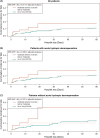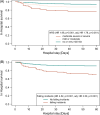Falls and malnutrition are associated with in-hospital mortality in patients with cirrhosis
- PMID: 39330948
- PMCID: PMC11441853
- DOI: 10.1097/HC9.0000000000000535
Falls and malnutrition are associated with in-hospital mortality in patients with cirrhosis
Abstract
Background: Hospitalized patients with end-stage liver disease are at risk of malnutrition, reduced body function, and cognitive impairment due to HE. This combination may have an impact on in-hospital falls and mortality. The purpose of this study was to identify factors associated with the risk of falls and to analyze the consequences regarding in-hospital mortality.
Methods: We performed a retrospective analysis of patients hospitalized with liver cirrhosis between 2017 and 2019 at the Department of Gastroenterology at the University Hospital Frankfurt. Clinical data, laboratory work, and follow-up data were analyzed. Factors associated with the risk of falls and in-hospital mortality were calculated using a mixed effect poisson regression model and competing risk time-to-event analyses.
Results: Falls occurred with an incidence of 4% (80/1985), including 44 injurious falls with an incidence rate of 0.00005/100 patient-days (95% CI: 0.00001-0.00022). In the multivariate analysis malnutrition (incidence risk ratio: 1.77, 95% CI: 1.04-3.04) and implanted TIPS (incidence risk ratio: 20.09, 95% CI: 10.1-40.1) were independently associated with the risk of falling. In a total of 21/80 (26.25%) hospitalizations, patients with a documented fall died during their hospital stay versus 160/1905 (8.4%) deaths in hospitalizations without in-hospital fall. Multivariable analysis revealed as significant clinical predictors for in-hospital mortality a Nutritional Risk Screening ≥2 (HR 1.79, 95% CI: 1.32-2.4), a falling incident during hospitalization (HR 3.50, 95% CI: 2.04-6.0), high MELD, and admission for infections.
Conclusions: Malnutrition and TIPS are associated with falls in hospitalized patients with liver cirrhosis. The in-hospital mortality rate of patients with cirrhosis with falls is high. Specific attention and measures to ameliorate these risks are warranted.
Copyright © 2024 The Author(s). Published by Wolters Kluwer Health, Inc. on behalf of the American Association for the Study of Liver Diseases.
Conflict of interest statement
Marcus Mücke consults and is on the speaker’s bureau for Advanz Pharma. He is on the speaker’s bureau and received grants from AbbVie. He consults for Sobi, and is on the speaker’s bureau for BioMarin. Stefan Zeuzem advises Bio Marin, Boehringer Ingelheim, GSK, Ipsen, Madrigal, and Novo Nordisk. He is on the speaker’s bureau for Abbvie, Gilead, and MSD/ Merck.
Figures




Similar articles
-
Falls are common, morbid, and predictable in patients with cirrhosis.J Hepatol. 2021 Sep;75(3):582-588. doi: 10.1016/j.jhep.2021.04.012. Epub 2021 Apr 19. J Hepatol. 2021. PMID: 33887359 Free PMC article.
-
Nutritional status and associations with falls, balance, mobility and functionality during hospital admission.J Nutr Health Aging. 2011 May;15(5):388-91. doi: 10.1007/s12603-010-0302-8. J Nutr Health Aging. 2011. PMID: 21528166
-
Nutritional care in hospitalized patients with chronic liver disease.World J Gastroenterol. 2015 Dec 7;21(45):12835-42. doi: 10.3748/wjg.v21.i45.12835. World J Gastroenterol. 2015. PMID: 26668507 Free PMC article.
-
Nutritional Status and its Impact on Clinical Outcomes for Patients Admitted to Hospital with Cirrhosis.J Med Assoc Thai. 2016 Feb;99 Suppl 2:S47-55. J Med Assoc Thai. 2016. PMID: 27266216
-
Malnutrition at Admission Predicts In-Hospital Falls in Hospitalized Older Adults.Nutrients. 2020 Feb 20;12(2):541. doi: 10.3390/nu12020541. Nutrients. 2020. PMID: 32093144 Free PMC article.
Cited by
-
LIVE-SMART: A sequential, multiple assignment randomized trial to reduce falls in cirrhosis.Hepatol Commun. 2025 Feb 19;9(3):e0626. doi: 10.1097/HC9.0000000000000626. eCollection 2025 Mar 1. Hepatol Commun. 2025. PMID: 39969429 Free PMC article.
References
-
- Asrani SK, Devarbhavi H, Eaton J, Kamath PS. Burden of liver diseases in the world. J Hepatol. 2019;70:151–71. - PubMed
-
- Paik JM, Golabi P, Younossi Y, Mishra A, Younossi ZM. Changes in the Global Burden of Chronic Liver Diseases from 2012 to 2017: The growing impact of NAFLD. Hepatology. 2020;72:1605. - PubMed
MeSH terms
LinkOut - more resources
Full Text Sources
Medical

